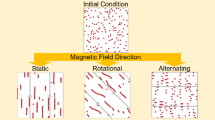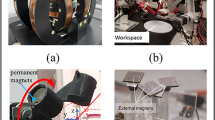Abstract
In this paper, we investigated the behavior of biofunctionalized, magnetic nanoparticle clusters under rotating magnetic fields in an aqueous solution to facilitate the use of such nanoparticles in biomedical applications. We found that two modes of motion for clusters of the nanoparticles exist. These two modes of motion exhibited by the clusters were rotation and oscillation, depending on the size of the cluster. Due to the interaction between the rotating magnetic field and the net magnetic dipole moment, the clusters were subjected to a forced vibration. A critical diameter range for the magnetic clusters was defined that may be used to distinguish between the rotation and oscillation of clusters. Furthermore, the characteristics of size dependence of the clusters’ motion were also investigated.





Similar content being viewed by others
References
Alexiou C, Arnold W, Klein RJ, Parak FG, Hulin P, Bergemann C, Erhardt W, Wagenpfeil S, Lübbe AS (2000) Locoregional cancer treatment with magnetic drug targeting. Cancer Res 60:6641–6684
Arruebo M, Fernandez-Pacheco R, Ibarra MR, Santamaria J (2007) Magnetic nanoparticles for drug delivery. Nano Today 2:22–32
Cēbers A, Javaitis I (2004) Bending of flexible magnetic rods. Phys. Rev. E 69:021404
Cēbers A, Ozols M (2006) Dynamics of an active magnetic particle in a rotating magnetic field. Phys Rev E 73:021505
Domínguez-García P, Melle S, Calderón OG, Rubio MA (2005) Doublet dynamics of magnetizable particles under frequency modulated rotating fields. Colloids Surf A 270:270–271
Enpuku K, Minotani T, Hotta M, Nakahodo A (2001) Application of high Tc SQUID magnetometer to biological immunoassays. IEEE Trans Appl Supercon 11:661–664
Enpuku K, Kuroda D, Ohba A, Yang TQ, Yoshinaga K, Nakahara T, Kuma H, Hamasaka N (2003) Biological immunoassay utilizing magnetic marker and high tc superconducting quantum interference device magnetometer. Jpn J Appl Phys 42:L1436–L1438
Enpuku K, Inoue K, SoeJima K, Yoshinaga K, Kuma H, Hamasaki N (2005) Magnetic immunoassays utilizing magnetic markers and a high-Tc SQUID. IEEE Trans Appl Supercond 15:660–663
Helgesen G, Pieranski P, Skjeltorp AT (1990a) Nonlinear phenomena in systems of magnetic holes. Phys Rev A 42:7271–7283
Helgesen G, Pieranski P, Skjeltorp AT (1990b) Dynamic behavior of simple magnetic hole systems. Phys Rev Lett 64:1425–1429
Hong CY, Wu CC, Chiu YC, Yang SY, Horng HE, Yang HC (2006) Magnetic susceptibility reduction method for magnetically labeled immunoassay. Appl Phys Lett 88:212512
Horng HE, Yang SY, Hong CY, Liu CM, Tsai PS, Yang HC, Wu CC (2006) Biofunctionalized magnetic nanoparticles for high-sensitivity immunomagnetic detection of human C-reactive protein. Appl Phys Lett 88:252506
Ito A, Shinkai M, Honda H, Kobayashi T (2005) Medical application of functionalized magnetic nanoparticles. J Biosci Bioeng 100:1–11
Kötitz R, Matz H, Trahms L, Weitschies W, Rheinländer T, Semmler W, Bunte T (1997) SQUID based remanence measurements for immunoassays. IEEE Trans Appl Supercond 7:3678–3681
Lee SK, Myers WR, Grossmanl HL, Cho HM, Chemla YR, Clarke J (2002) Magnetic gradiometer based on a high-transition temperature superconducting quantum interference device for improved sensitivity of a biosensor. Appl Phys Lett 81:3094–3097
Melle S, Calderón OG, Fuller GG, Rubio MA (2002) Polarizable particle aggregation under rotating magnetic fields using scattering dichroism. J Colloid Interface Sci 247:200–209
Pankhurst QA, Connolly J, Jones SK, Dobson J (2003) Applications of magnetic nanoparticles in biomedicine. J Phys D 36:R167–R181
Ruehm SG, Corot C, Vogt P, Kolb S, Debatin JF (2001) Magnetic resonance imaging of atherosclerotic plaque with ultra small super paramagnetic particles of iron oxide in hyperlipidemic rabbits. Circulation 103:415–422
Tartaj P, Morales MDP, Veintemillas-Verdaguer S, González-Carreño T, Serna CJ (2003) The preparation of magnetic nanoparticles for applications in biomedicine Phys. D-Appl Phys 36:R182–R197
Todd P, Cooper RP, Doyle JF, Dunn S, Vellinger J, Deuser MS (2001) Multistage magnetic particle separator. J Magn Magn Mater 225:294–300
Weitschies W, Kötitz R, Bunte T, Trahms L (1997) Determination of relaxing or remanent nanoparticle magnetization provides a novel binding-specific technique for the evaluation of immunoassays. Pharm Pharmacol Lett 7:1–7
Wust P, Hildebrandt B, Sreenivasa G, Rau B, Gellermann J, Riess H, Felix R, Schlag PM (2002) Hyperthermia in combined treatment of cancer. The Lancet Oncol 3:487–497
Yang SY, Wang WC, Lan CB, Chen CH, Chieh JJ, Horng HE, Hong CY, Yang HC, Tsai CP, Yang CY (2010) Magnetically enhanced high-specificity virus detection using bio-activated magnetic nanoparticles with antibodies as labeling markers. J Virol Methods 164:14–18
Zhao M, Beauregard DA, Loizoul L, Davletov B, Brindle KM (2001) Non-invasive detection of apoptosis using magnetic resonance imaging and a targeted contrast agent. Nat Med 7:1241–1244
Acknowledgments
This study was supported by the National Science Council of Taiwan under grant number 99-2221-E-005-041-MY3 and by National Chung Hsing University under grant number 100S0901.
Author information
Authors and Affiliations
Corresponding author
Rights and permissions
About this article
Cite this article
Lai, JC., Tang, CC. & Hong, CY. Size-dependent motion of bio-functionalized magnetic nanoparticle clusters under a rotating magnetic field. J Nanopart Res 15, 1378 (2013). https://doi.org/10.1007/s11051-012-1378-3
Received:
Accepted:
Published:
DOI: https://doi.org/10.1007/s11051-012-1378-3




